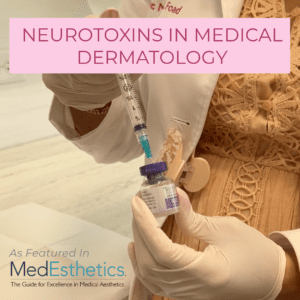Neurotoxins in Medical Dermatology | As Featured in MedEsthetics
Learn more about neurotoxins in MedEsthetics‘ article and hear how Dr. Alexandra Bowles incorporates them into her her practice of medical dermatology.

Besides cosmetic use, how are neurotoxins being used in dermatology for skin conditions?
They are being used to treat various skin conditions. For example, they can be used to manage hyperhidrosis, commonly known as excessive sweating. In cases of rosacea, microbotox has been shown to reduce redness in some patients. Additionally, neurotoxins can help alleviate tension headaches and teeth grinding by targeting and relaxing the overactive muscles that contribute to these issues.
What’s your approach to using neurotoxins safely and effectively for skin treatments?
My approach is to treat each patient individually! No two patients receive the same treatment, everyone requires different amounts and that botox can be placed precisely based on each patient’s concerns. I am always someone that also starts low and increases based on the patient’s wishes. Botox done properly is very safe and effective. It is important that your injector is well versed in the mechanism of botox and the anatomy of the patient.
Are there any new uses of neurotoxins in dermatology that you find exciting?
Microbotox for rosacea is really exciting to me! Rosacea is a difficult chronic condition to treat. Studies have shown promising results when treating rosacea and I would love for it to become a more well-known option.
